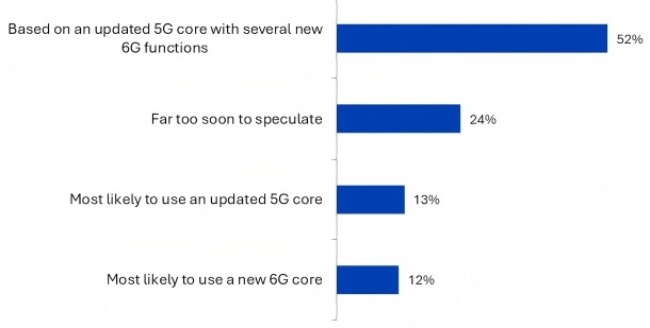6G Standardization: A Basic Consensus Reached on Adopting a Single-architecture SA (Standalone) Mode.
As the development of 6G standards progresses, system architecture decisions that will determine the long-term direction of 6G development will be made in a relatively short period of time. Gabriel Brown, Senior Principal Analyst at Omdia, points out that the challenge lies in designing a system that can continuously evolve to meet the advanced, large-scale service demands of 2040, while ensuring that its initial deployment is economically viable within the current business model.
3GPP Points the Way for a "Single Architecture" for 6G
6G will adopt a standalone (SA) architecture from the outset, based on a single architecture. This was the clear message conveyed by the mobile network ecosystem when it launched 6G research in 3GPP Release 20. There is a near-universal agreement in the industry that 6G requires a simpler architecture with fewer options than 5G, and a faster path to large-scale commercialization.
These views were widely discussed at the 3GPP Technical Steering Group 6G plenary meeting in March and are reflected in the agendas of two research projects approved in June: "6G System Architecture Study" and "6G Radio Study" (also known as 6GR).
In practical scenarios, a 6G SA architecture will likely mean that the 6G RAN will be deployed in shared 5G spectrum and new 6G spectrum (such as upper mid-bands or the FR3 "golden band"), connected to the 6G core network. The goal of this architecture is to achieve a fast and cost-effective migration to 6G SA.
MRSS + New 6G Radio Equipment + New 6G Core Network
The proposed 6G SA architecture relies on Multi-RAT Spectrum Sharing (MRSS). MRSS utilizes a forward-compatible “simplified carrier” 5G physical layer to provide a low-overhead 5G/6G sharing mechanism, avoiding the severe interference problems encountered in 4G/5G Dynamic Spectrum Sharing (DSS).
MRSS will play a key role in the early and mid-stages of 6G deployment. Shared low- and mid-band spectrum will provide the basic coverage layer for 6G. This model is investment-friendly because it allows 6G to reuse existing 5G radio equipment and antennas. In its simplest form, this architecture requires only baseband upgrades (potentially just software upgrades), a core network (evolved from the 5G core network), and compatible equipment.
However, to meet capacity and performance requirements, 6G will also require new spectrum, necessitating the deployment of new radio equipment on both sides of the air interface—mobile devices and the RAN. The basic concept is shown in Figure 1 below: As the user base migrates to 6G, 6G will occupy a larger share of available spectrum, while the importance of MRSS will decrease accordingly.
The industry has strongly supported the MRSS + 6G core network architecture. However, the complexity and combinations of various carrier aggregation scenarios are still undetermined, and there are still some uncertainties regarding how MRSS will operate in practical applications. Furthermore, in MRSS scenarios, highly optimized 5G/6G RAT handover is crucial.

The industry is also discussing whether an additional 6G RAN option based on dual connectivity or dual stack/dual routing is needed to provide higher performance services than MRSS alone. Both options would increase complexity and need to provide clear value to be part of a "single architecture" standard. At this stage, dual stack and dual connectivity solutions require further research.
Evolving 5G Core Network Infrastructure to Support 6G
A recent Heavy Reading (an Omdia subsidiary) survey, "5G Core Network Operator Survey (2025 Edition)," reflects industry support for reusing and evolving 5G service-based architectures and 5G core networks to create new 6G core networks.
The survey inquired about network operators' views on the evolution path of 6G core networks. The chart below shows that the majority of respondents (52%) believe the 6G core network will be "based on an updated 5G core network with the addition of several new 6G features," while only 12% believe it will "adopt a completely new 6G core network." This implies that current investments in 5G core network infrastructure (cloud platforms, CNFs, etc.) and operational tools will continue in some form into the 6G era. It's understandable that approximately one-quarter (24%) of respondents stated that "it's too early to speculate."
In addition to discussions about 6G core network functions and architecture, cloud platforms currently deployed and expanded to run 5G core network workloads are likely to be used to support initial 6G deployments. This means that regardless of the decisions made regarding specific 6G core network functions, investments in telecom cloud will be reused.

New 6G Core Network Functions
The main new 6G core network functions that may be needed are the signaling nodes that control mobility and session management—referred to as Access Management Function (AMF) and Session Management Function (SMF) in 5G, respectively.
6G provides an opportunity to build a more streamlined control plane, supporting only the signaling required to establish and maintain data services such as security, mobility, and session management. This will simplify the Non-Access Stratum (NAS) and reduce the complexity of the RAN and device software stack. This approach aligns with the industry's need for a simpler, easier-to-implement standard.
6G AMF and SMF will be software functions, possibly co-located with 5G AMF and SMF, or even software upgrades of existing functions to make them dual-mode 5G/6G capabilities. Either way, the capital expenditure required for these new functions will be lower.
Economic Efficiency and Value-Driven Network Architecture
6G development is still in its early stages. However, as standards development progresses, system architecture decisions that will determine the long-term direction of 6G will be made in a relatively short period. During this process, the feasibility of the 6G system architecture, how it will achieve a smooth transition from 5G, and the value it will bring to customers must be fully considered.